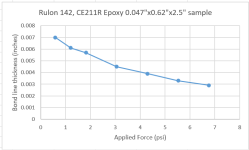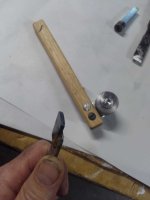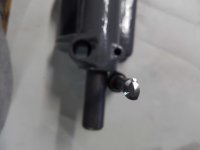You could also do a practice piece on a steel block first, but it's easy. Be sure to over roughen and clean the iron and spray Rulon dark side. In my classes I show the students a trick if you forget what side to glue, cut a small piece of the Rulon off the roll and pour water on each side. The dark side wicks in and the green side it beads up as that's where it fails if done wrong. You can also shine a light on it to heat it up before and during if your concerned with the low temp. If your good at rebuilding and are looking for a full or part time job my friend in Springfield, VT was looking for help in rebuilding used machines. Private message me for details.
I hope I didn't tick you off by adding my 2 cents worth as I teach and I believe it's my calling. I know I tick some folks off by adding my advise. I hate seeing bad advise and the other readers screw something up.. Not many people who write here have been getting paid to rebuild machine tools for over 50 years. Happy New Year! Rich
Richard I took no offense to anything you said and appreciate your thoughtful comments. Tristar also recommends the water beading check on old product to check if the etched surface is still good for glueing to.
I have done a little reading on spray can brake cleaners. Turns out there are 2 kinds. Chlorinated and non-chlorinated. Chlorinated brake cleaner was initially trichloroethane; it has been mostly replaced by tetrachloroethylene, (perchloroethylene, Perc), Methylene chloride and dichloroethylene due to ozone depletion. These are often advertised as non-flammable and fast drying. They are high VOC and mildly cancer causing and have thus been banned by California. These brake cleaners create deadly gasses if heated, phosgene and hydrogen chloride ( think WW2 chemical warfare). Be very careful about using a torch and brake cleaner on the same part as I saw in your posted video. I contacted Tristar and they said it would be OK to use chlorinated cleaners for cleaning prior to glueing on the Rulon.
The newer slightly more environmentally friendly and expensive brake cleaners are non-chlorinated. They may have a variety of petroleum hydrocarbons as well as polar solvents such as ethanol, methanol, IPA and acetone. They tend to be not quite as effective, do not evaporate quite as fast and are extremely flammable. The chemist at Tristar said he would not recommend non-chlorinated brake cleaners because they have found anything with hydrocarbons to be unreliable. Their most recent literature suggests 95% IPA , it has a strong desiccating, drying effect removing moisture that causes adhesion problems. I had to shop around some to find higher strength IPA, most places around here carry 70%. Some of their older literature says Acetone is another option.
I have seen some brake cleaners affect some kinds of plastics, it will ruin the plastic cover on a pressure gauge. One reference I found said it will have no immediate effect on rubber hoses but the rubber will harden and crack within weeks or months. Rulon 142 is PTFE (like teflon) and is unaffected by most chemicals.
Tristar also said the plan Richard suggested of using a putty knife to spread the glue in a thin uniform layer and then rakeing it in opposite directions with the notched trowel is good. They confirmed my suspicion the trowel they provided is not optimum. Tristar has a lot of technical info on the website tstar.com but is not set up for internet sales to the public. It was not too painful, I contacted them via the website, they sent me a quote, I called back with billing info and they wanted to know my corporate fedex account number, they ended shipping it (USPS I think) and then charged me later ($34) after sending it out.
Not sure how to attach a pdf of the instructions






















